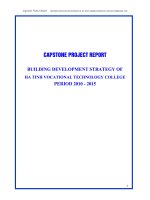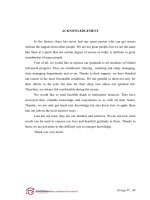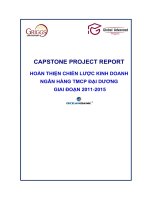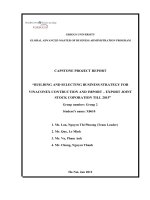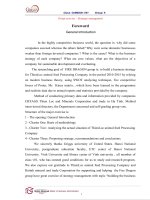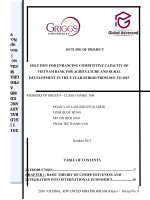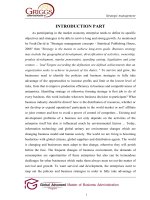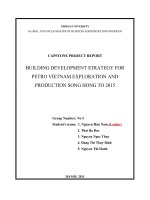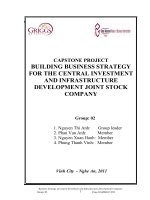Luận văn thạc sĩ quản trị kinh doanh quốc tế MBA (167)
Bạn đang xem bản rút gọn của tài liệu. Xem và tải ngay bản đầy đủ của tài liệu tại đây (452.24 KB, 67 trang )
GRIGGS UNIVERSITY
GLOBALADVANCED MASTER OF BUSINESS ADMINISTRATION PROGRAM
CAPSTONE PROJECT REPORT
DEVELOPING BUSINESS STRATEGIES
OF VIETNAM COMMERCIAL JOINT STOCK BANK
FOR INDUSTRY AND TRADE –
CUA LO BRANCH (VIETINBANK CUA LO)
IN THE PERIOD OF 2011 - 2015
Group No.11
Student’s name:
1.
Ho Xuan Bay
2.
Nguyen Ngoc Thanh
3.
Ha Xuan Quang
4.
Nguyen Tuan Dung
Hanoi, 2011
1
TABLE OF CONTENTS
INTRODUCTION...................................................................................................5
1. General context, the necessity and the urgency of the research..........................5
2. Subject and purpose of the research...................................................................7
3. Research methodology.......................................................................................7
4. Structure of the capstone:...................................................................................7
CHAPTER I.............................................................................................................7
THEORETICAL FOUNDATION OF...................................................................7
BUSINESS STRATEGY.........................................................................................7
1.1. Business strategy.............................................................................................7
1.1.1. Definition of business strategy..................................................................7
1.1.1.1. Different definitions of business strategy...............................................7
1.1.1.2. Basic characteristics of business strategy...............................................8
1.1.2. The role of business strategy for an enterprise:.........................................9
1.1.2.1. Focusing development.........................................................................10
1.1.2.2. Three competitive strategies.................................................................10
1.1.2.3. Competitive strategies for enterprises based on market share and
position:.........................................................................................................10
1.2. Process of developing strategy......................................................................11
1.2.1. Defining the mission and objectives........................................................11
1.2.2. Analyzing external environment.............................................................12
1.2.3. Analyzing the enterprise’s internal environment.....................................12
1.2.4. Developing the strategic alternatives.......................................................12
1.2.5. Analyzing and selecting strategies..........................................................13
1.3. Tools for strategic analysis............................................................................14
1.3.1. Using PEST Method to analyze macro factors........................................14
1.3.2. Using Michael Porter’s Five Forces of Competition to analyze micro
factors...............................................................................................................15
1.3.3. Using EFE Matrix to analyze the Opportunities and Threats..................15
1.3.4. Using IFE Matrix to analyze the strengths and weaknesses....................15
1.3.5. Using SWOT Matrix to qualitatively analyzing the strategy...................16
V0110.CapstoneProjectReport.Group11
2
1.3.6. Using QSPM to analyze and select strategies..........................................17
CHAPTER II.........................................................................................................18
BUSINESS ENVIRONMENT SITUATIONS OF...............................................18
VIETINBANK CUA LO.......................................................................................18
2.1. General introduction......................................................................................18
2.1.1. Establishment and development history..................................................18
2.1.2. Organizational chart................................................................................19
2.1.3. Distribution network...............................................................................20
2.1.4. Service offerings.....................................................................................21
2.1.5. Business performance throughout the years............................................22
2.2. Analysis of factors affecting the operations of VietinBank Cua Lo...............23
2.2.1. Macro environment (PEST model).........................................................23
2.2.1.1. Economic environment........................................................................23
2.2.1.2. Socio-cultural environment..................................................................27
2.2.1.3. Political and legal environment............................................................28
2.2.1.4. Natural environment.............................................................................29
2.2.1.5. Technological environment..................................................................29
2.2.2. Micro environment (industrial) – M. Porter’s Five Forces......................30
2.2.2.1. Competitors..........................................................................................32
2.2.2.2. Customers............................................................................................35
2.2.2.3. Suppliers..............................................................................................36
2.2.2.4. Potential competitors............................................................................37
2.2.2.5. Substitutes............................................................................................38
2.2.3. Evaluation of opportunities and threats...................................................39
2.2.4. External Factor Evaluation (EFE) Matrix...............................................40
2.3. Analysis of internal factors of VietinBank Cua Lo........................................41
2.3.1. Human resources.....................................................................................41
2.3.2. Marketing................................................................................................42
2.3.3. Organizational structure..........................................................................43
2.3.4. Management capability...........................................................................43
V0110.CapstoneProjectReport.Group11
3
2.3.5. Financial capability.................................................................................44
2.3.6. Research & Development.......................................................................44
2.3.7. Information technology...........................................................................44
2.3.8. Evaluation of strengths and weaknesses..................................................45
2.3.9. Internal Factor Evaluation (IFE) Matrix..................................................46
2.4. Matrix analysis..............................................................................................47
2.4.1. SWOT matrix analysis............................................................................47
2.4.2. Proposed strategies from the SWOT Matrix...........................................48
CHAPTER III........................................................................................................49
BUSINESS STRATEGY SELECTION AND IMPLEMENTATION
SOLUTIONS OF VIETINBANK - CUA LO BRANCH FOR THE PERIOD OF
2011 - 2015..............................................................................................................49
3.1. Business goals and objectives of VietinBank - Cua Lo Branch.....................49
3.1.1. General goals..........................................................................................49
3.1.2. Specific objectives by 2015.....................................................................49
3.2. Selection of feasible business strategies........................................................49
3.2.1. Selection of strategic alternatives............................................................49
3.2.2. Business strategy determination..............................................................51
3.2.3. Strategic position of Cua Lo Branch in comparison with the system of
Vietinbank.........................................................................................................52
3.3. Strategy implementation solutions................................................................52
3.3.1. Human resource development solutions..................................................52
3.3.1.1. Human resource recruitment improvement..........................................53
3.3.1.2. Employee training and retraining.........................................................53
3.3.1.3. Human resource management and reward & compensation policies. . .54
3.3.2. Marketing solutions.................................................................................54
3.3.2.1. Market research....................................................................................55
3.3.2.2. Marketing Mix.....................................................................................56
3.3.3. Technology solutions...............................................................................59
3.3.4. Developing organizational culture..........................................................59
3.3.5. Developing infrastructures and facilities.................................................61
V0110.CapstoneProjectReport.Group11
4
3.4. Implementation progresses............................................................................61
3.5. Potential problems and solutions...................................................................62
CONCLUSION......................................................................................................63
BIBLIOGRAPHIES..............................................................................................63
LIST OF TABLES AND FIGURES
Figure 1.1
Table 1.1
Table 1.2
Table 1.3
Figure 1.4
Figure 2.1
Figure 2.2
Table 2.1
F.David’s Model of Strategic Management
EFE Matrix
IFE Matrix
SWOT Matrix
Quantitative Strategic Planning Matrix
Organizational chart of VietinBank system
Organizational Chart of VietinBank Cua Lo
GDP growth rate of Vietnam and regions including Nghe An and
Cua Lo as a function of time
Table 2.2
Figure 2.3
Table 2.4
Table 2.5
CPI of Nghe An as a function of time
Summary of the macro factors influencing Vietinbank Cua Lo
Comparison of Vietinbank branches in Nghe An
Comparison of Vietinbank Cua Lo with branches of
Figure 2.6
Table 2.7
Table 2.8
Table 2.9
Figure 3.1
Vietcombank, BIDV, Agribank in Nghe An
Summary of micro factors influencing Vietinbank Cua Lo
The EFE Matrix of VietinBank Cua Lo
The IFE Matrix of VietinBank Cua Lo
The SWOT Matrix of VietinBank Cua Lo
Internal - External Matrix (IE) of VietinBank Cua Lo
INTRODUCTION
1. General context, the necessity and the urgency of the research
The current context of global economic crisis such as debt ceiling issues in the
United States and many European countries have strong impact on the world’s
financial market.
V0110.CapstoneProjectReport.Group11
5
Because of the fact that Vietnam gradually integrates into the world’s economy,
all the fluctuations of global economy also have impacted significantly to the
economy of Vietnam. The banking system of Vietnam has faced many difficulties
since early 2001 till now.
Firstly, it is the force to reach the target of controlling the increasing inflation.
Banking system has to face liquidity difficulties, and it is difficult for every bank,
even the biggest ones, which are considered to be the market makers.
Secondly, if the interest rate was completely decided by the banks in the past,
this role, now, is transferred to customers, especially customers who hold a huge
amount of Vietnam Dong (VND). However, it is the state organizations that bargain
for interest rate the most. There is institution that organized bidding for capital cost
for deposit, and the winner would be the bank that offers the higher payment.
Thirdly, it is merging and acquisition in banking sector. For many years,
observing the low liquidity and weak financial situation of many banks, which
resulted from unhealthily quick growth, under-standard lending and low safety
ratio,
many people have asked for, in these cases, to conduct merging and
acquisition, resale or announce bankruptcy in order to make the market grow
strongly again, however, it has never happened since.
Fourthly, the foreign currency exchange market, after few years of chaotic rate
variability, it is now settled down through series of decisive action. However, far
behind that success was the power of the administration, instead of tools with
regulating senses.
In this context, many banks have to develop or adjust their business strategies to
suit the market conditions. Vietnam Joint Stock Commercial Bank for Industry and
Trade - Cua Lo Branch (Vietinbank Cua Lo) is one of the best-operated branches in
the Vietin Bank system of Nghe An province and the whole Vietin Bank in general.
However, in the volatile situation of the market and severe competition, Vietinbank
Cua Lo has to build their own business strategy to develop and compatible with the
strategy of the Bank’s overall system.
V0110.CapstoneProjectReport.Group11
6
2. Subject and purpose of the research
- Subject of the research: Vietinbank - Cua Lo Branch
- Purpose of the research: Developing business Strategies for Vietin Bank Cua
Lo in the period of 2011 – 2015 and propose solutions to make it become the
1st ranking branch in the Vietinbank system.
3. Research methodology
- References: primary and secondary data, data of Vietinbank Vietnam,
Vietinbank Cua Lo, Reports of the People’s Committee of Nghe An
-
Province
Analyzing technique: IFE, EFE, SWOT and QSPM matrices, Michael
Porter’s five forces model of competition
4. Structure of the capstone:
Chapter 1: Rational foundation of business strategy
Chapter 2: Business Environment situations of Vietin Bank Cua Lo
Chapter 3: Business strategy selection and implementation solutions of VietinBank
– Cua Lo for the period of 2011 - 2015.
CHAPTER I
THEORETICAL FOUNDATION OF
BUSINESS STRATEGY
1.1. Business strategy
1.1.1. Definition of business strategy
1.1.1.1. Different definitions of business strategy
Alain Threlart stated that "Strategy is the art that an enterprise uses to stand
against competition and win"
V0110.CapstoneProjectReport.Group11
7
According to M. Porter, "Strategy is the art of building solid competitive
advantages to defense"
For these reasons, the authors considered business strategy as a kind of art to
compete in the market and develop the enterprise.
According to the viewpoint of management, business strategy is a kind of plan:
- G. Arlleret stated that "Strategy is the determination of the roads and the
means to achieve the objectives defined by the policy"
- D. Bizrell et al defined strategy “as a general plan or direction that leads the
enterprise to the desired goal. It is the basis for the elaboration of the policies and
operational measures. "
- Gluecl stated that: "The strategy is consistent, comprehensive and
integrated plan designed to ensure that the enterprise’s objectives will be
implemented.
According to the perspective of consistency:
- "Strategy is the art of coordinating activities and controlling them to
achieve long-term goals of the enterprise".
- Chandler defined that “strategy involves defining basic long-term goals of
the enterprise and in the same time choosing the mode or courses of actions and
allocate the necessary resources and implement those goals”
In an enterprise: "Strategy is the art of organizational design aimed to
facilitate long-term goals of the business and it has the relationship with the change
of business environment and competitiveness”.
There are many definitions of Business strategy and each scholar has his own
approach and research method. However, it can be seen that all of these definitions
have a common point “Business strategy involves competing to achieve business
goals”. In this capstone project, we synthetize and apply the concept of business
strategy through its characteristics and role.
1.1.1.2. Basic characteristics of business strategy
- Business strategy determines the basic objectives and business direction of the
enterprise in a specific period.
V0110.CapstoneProjectReport.Group11
8
- The orientation of the strategy is to ensure the continuity and firm of the
development in the constantly fluctuating business environment.
- Business strategy ensures to mobilize at het maximum and combines at the
optimal of extraction and use of enterprise resources at the present and in the future.
It also promotes the advantages and seizes the opportunity to competition.
- Business strategy an enterprise is reflected throughout a continuous process.
- Business strategy always peruses attacking thoughts in order to win in the
marketplace.
- Business strategies are often built in a long period of time (3, 5 to 10 years).
1.1.2. The role of business strategy for an enterprise:
- Business strategy helps the enterprise to identify the purpose and its basic
direction as the guideline for all manufacturing and business activities of the
enterprise. Business strategy plays an orienting role in the long-term operation of
the business; it is a solid basis for the deployment of the operation. The lack of
strategy or when strategy is unclear or when there is no solid argument will make
the operation of the enterprise lost its way. There are many problems that can only
be seen in the immediate future but could not be associated with long-term plan and
cannot be seen as the main role in the whole activities of the enterprise.
- Business strategy helps the enterprise understand and take advantage of
business opportunities, and in the same time take measures to overcome the risks
and threats in the competitive marketplace.
- Business strategy contributes to improve the efficient use of resources, enhance
the competitive position of the enterprise and ensure its sustainable development.
- Business strategy creates a solid basis for the proposal of policies and decisions
for suitable production that work in accordance with the fluctuation of the market. It
forms a solid basis for research and development, investment and development of
personnel training, expanding the market and product development. In fact, most of
the mistakes in investment, technology, markets come from developing strategy or
any problems in determining strategic objectives.
V0110.CapstoneProjectReport.Group11
9
The foundation for success or failure depends on an important factor of how the
enterprise’s business strategy looks like.
1.1.2.1. Focusing development
This strategy is to improve the competitive position of enterprises in comparison
with the existing products based on enhancing marketing activities or changing the
existing market strategy without changing the product. It comes in three main
strategies:
- Market penetration: increase the market share for available products and
services available in the market through marketing activities.
- Market development: Provide products and services available in the new area.
- Product development: Increasing in sales, innovating in available products and
services.
1.1.2.2. Three competitive strategies
1.
Cost-leading strategy
Cost-leading strategy is driven by the overall action to provide products or
services that have the characteristics accepted by customers with the lowest cost
compare to all competitors.
2.
Product differentiation
The objective of the differentiation strategy is to gain the competitive
advantage for the enterprise through creating products (goods or services) that is
unique in some features to the customers. Enterprise that tries to make the
difference to satisfy the customers in a way that no competitors cannot offer higher
price (a significantly price that is above the industry’s average)
3.
Focus strategy
Focus strategy is the third among three generic competitive strategies. The
main difference with the two strategies is that it is directed to serve the needs of a
group of customers. A focus strategy will work on a specific market gap that can be
determined in terms of geography, customer type, or by product segment.
1.1.2.3. Competitive strategies for enterprises based on market share and
position:
V0110.CapstoneProjectReport.Group11
10
Although they are in the same industry, but each enterprise has a different
market share position:
- The leader in the market
- The enterprises that challenge the market
- The enterprises that follow the market
- The enterprises that lurk in the market
1.2. Process of developing strategy
Figure 1.1 F.David Model of Strategic Management
The process of developing is the first stage in strategic management. There
are four steps in building up the strategy:
1.2.1. Defining the mission and objectives
Vision: Claims of enterprise on their position in business environment in a
certain period of time – is guidelines for company’s action in all the times and
circumstances.
Mission: The mission of an organization is actually its business purpose, its
reason for the establishment, survival and development. Business mission of an
organization answer the question: What is the reason for an organization to be
established and exist?
V0110.CapstoneProjectReport.Group11
11
Objective: The objective is the state, the specific results that the organization
wants to achieve over a period of time. Most organizations pursue profit and goals
of excellence and leading position. The second objective is the goal that the
organization thinks it is necessary to achieve remarkable capacity.
1.2.2. Analyzing external environment
They are the elements, these forces and the alternatives that locate outside that
the enterprise that the administrators could not control, but they have strong effect
on the operation and performance of the enterprise.
The environment of an enterprise includes:
+ Macro-environment (general environment) includes factors like the economy,
politics, legislation, technology, culture and society, nature.
+ Micro-environment (specific environment) includes factors like customers,
suppliers, industry competitors, potential competitors, replacement products.
The aim here is to identify and understand the related environmental
conditions to clarify the environmental factors that are likely to influence the
decisions of the enterprise.
Evaluating the opportunities and challenges from the external environment
that affect the enterprise will allow the enterprise to build a suitable business task
and set out clear policies to achieve the goals.
1.2.3. Analyzing the enterprise’s internal environment
Analyzing the internal environment of the enterprise in order to find out the
strengths and weaknesses, ways to achieve competitive advantage, and the role of
different capacities, resources and capacity to build and maintain sustainable
competitive advantage for the business.
The internal environment is analyzed based on functional activities such as
human resources, technical infrastructure, technology and finance.
1.2.4. Developing the strategic alternatives
After analyzing the factors of the macroeconomic and business environment,
the enterprise often has to identify opportunities and risks from external
environment, the strengths and weaknesses from the internal environment of the
V0110.CapstoneProjectReport.Group11
12
enterprise used as the foundation for developing orientation and strategic plan. The
main technique that used is analyzing the strengths, weaknesses, opportunities and
threats. (SWOT Matrix)
SWOT analysis provides useful information for connecting the resources and
capabilities of the enterprise within the competitive environment that it operates. It
is also the tool to set up and selecting the strategy. SWOT Matrix is a method of
analyzing the strengths, weaknesses, opportunities and threats.
Analyzing SWOT Matrix provides tools for strategic analyzing, review and
evaluating the position and the orientation of an enterprise or a business plan.
SWOT is suitable for working and analyzing in groups, it is used in business
planning, strategy development, competitor evaluation, marketing, product
development and services.
SWOT Analysis is the assessment of data held by a SWOT model in order to
understand, present, discuss, and apply. Four-dimensional evaluation of the SWOT
is an extension of two-dimensional "strengths" and "weakness". SWOT analysis can
be used for any decision and the SWOT model allows positive thinking, beyond any
framework of habit or instinct. When analyzing SWOT, we need to identify clearly
the purpose of the target, and then we can expect others to contribute to the analysis
process. The people who see the results of the analysis could understand the
purpose of analytical methods, evaluation and the relationship between the SWOT
factors. This is a simple method in business that is easy to apply and can be used in
many areas of business.
1.2.5. Analyzing and selecting strategies
When choosing a strategy, an enterprise should consider a number of factors
that affect the strategic choices. These factors include both objective and subjective
factors, namely the strengths of the industry and enterprises, strategic objective of
the enterprise, leaders’ attitude in the enterprise, financial sources, ability and
capacity of the managers, the reflection of the subjects and the deadline.
Some foundations for selecting strategies
V0110.CapstoneProjectReport.Group11
13
- The power of the enterprise and the industry in comparison to other
competitors that may influence the strategic choices.
- Tasks and objectives: The system of goals that the board of directors has
given that could directly affect the choice of strategy. The point here is to choose the
appropriate strategy for the target and duties of enterprises rather than only the
profit or growth.
- The viewpoint of the executive director has a direct effect the choice of the
strategy, especially the attitude of the executives towards risk.
- Financial capacity of the enterprise also has the influence and some of them
even put pressure on the strategy selection. The bigger and convertible the capital
an enterprise has, the easier for it to pursue opportunities, but some have to give up
due to insufficient financial capacity.
- Capabilities and qualifications of business administration staff of the
enterprise also govern the selection of strategy. This factor plays a more or less a
role in the implementation of the strategies and to the success of a strategy.
- The time factor: The success of a strategy may depend heavily on
identifying the right time for implementation.
- Results of the current strategic review of your business: Identifying the
exact current strategy of the enterprise as a basis for choosing the new strategy and
confirm the current strategy.
1.3. Tools for strategic analysis
1.3.1. Using PEST Method to analyze macro factors
PEST studies the impacts of the factors in the macro environment. Those
factors are:
Political factors
Economic factors
Socio-cultural factors
Technological factors
These four factors have a direct impact to the economy. Other than that, there
are natural conditions which are external factors of the enterprise and the industry
V0110.CapstoneProjectReport.Group11
14
which must take the effects it provides as objective element. The enterprises will
base on these impacts to create suitable policies and business activities accordingly.
1.3.2. Using Michael Porter’s Five Forces of Competition to analyze micro
factors
Porter’s Five Forces Model was first printed in the Harvard Business Review
in 1979 with the content is to understand the factors that create profits in business. It
is called Porter’s Five Forces Model and considered as a useful and effective tool to
learn about the source of profits. More importantly, this model offers competitive
strategies for the enterprise to maintain and increase business profitability.
1.3.3. Using EFE Matrix to analyze the Opportunities and Threats
The specialists have come up with the EFE Matrix to evaluate the external
factors
Table 1.1: EFE Matrix
External Factors
(1)
List all the external
Weigh
(2)
Grading from 0 to
Rating
(3)
1 = low reaction
factors of the
1, the higher the
2 = average reaction
enterprise
weight, the more
3 = above average
(international, local,
important the
reaction
industry)
factor
Total = 1
4 = good reaction
Weighted Score
(4)
(4) = (2)x(3)
Total = X
1.3.4. Using IFE Matrix to analyze the strengths and weaknesses
Specialists have come up with the IFE Matrix to evaluate the internal factors:
Table 1.2: IFE Matrix
Internal Factors
(1)
Listing all the
Weight
(2)
Grading from 0 to 1,
V0110.CapstoneProjectReport.Group11
Rating
(3)
1 = weakest point
15
Weighted Score
(4)
(4) = (2)x(3)
internal factors
the higher the weight,
2 = weak
of the enterprise
the more important
3 = strong
the factor
Total = 1
4 = strongest point
Total = Y
1.3.5. Using SWOT Matrix to qualitatively analyzing the strategy
Analyzing the Strengths – Weaknesses – Opportunities – Threats
SWOT stands for Strengths (S), Weaknesses (W), Opportunities (O) and Threats
(T). This is a very useful matrix that helps us to study an issue or make decision in
managing or organizing in business.
Table 1.3: SWOT Matrix
Internal Environment
Strengths (S)
Weaknesses (W)
of the enterprise List all the important
List all the important
External
strengths from the Table of
weaknesses from the Table of
Environment
internal factors of the
internal factors of the
of the enterprise
Opportunities (O)
enterprise
Combination S-O
enterprise
Combination W-O
List all the important
Make advantage of the
Make use of external
opportunities from the
enterprise’s strengths to
opportunities to overcome the
Table of external factors
develop the opportunities in
internal weaknesses of the
of the enterprise
Threats (T)
the external environment
Combination S-T
enterprise
Combination W-T
List all the important
Make use of the internal
Combination of protecting
threats from the Table of
strengths to reduce the
strategies, which is overcoming
external factors of the
impact of external threats
weaknesses and reduce or
enterprise
avoid external threats
S-O Strategy: using the strengths of the enterprise to make advantages of
the external opportunities
W-O Strategy: overcome the weaknesses to make advantage of external
opportunities
S-T Strategy: using the strengths of the enterprise to deal with the external
threats
W-T Strategy: overcome the weaknesses to reduce the external threats
V0110.CapstoneProjectReport.Group11
16
1.3.6. Using QSPM to analyze and select strategies
Quantitative Strategic Planning Matrix - QSPM uses the in-put data from the
above analysis (mentioned in the previous chapters) to help strategists subjectively
determine which strategy in a alternative set of strategies is the most appropriate for
the company to pursue in order to successfully accomplish its objectives.
Table 1.4 Quantitative Strategic Planning Matrix
Rating
(2)
Alternatives
Alternative
Alternative
Alternative
1
2
3
A
B
A
B
A
B
Internal factors
External factors
Total
S
S
S
In principle, a QSPM can include any group of strategies in an alternative set
of strategies which include any strategy; but only strategies in the same group can
be evaluated and compared. These groups of strategies are different and a QSPM
can only evaluate strategies in the same group.
It should be noted that QSPM shows the comparative attractiveness of the
alternative strategies; and more importantly it provides subjective bases to consider
and determine the most appropriate product strategy. However, QSPM also has
some limitations and it must have certain conditions to be used in practice. One of
the biggest drawbacks is that in the process of developing the matrix, intuitive
judgement is required to give the factors the attractiveness score - although based on
the environmental analysis information conducted before. Therefore, in order to
effectively use QSPM, strategists are required to discuss thoroughly and reach a
consensus on each number in the matrix by adding scoring bases in the
attractiveness score column.
Strategy selection is the final determinant step of the strategy development
and also the first step in the strategy implementation process. Developing and
V0110.CapstoneProjectReport.Group11
17
selecting strategies can identify steps required to have a feasible business strategy.
However, to be successful in the marketplace, selecting the appropriate strategy is
essential and crucial. And with the selected strategy, the company must implement it
effectively. This is a critical stage to translate the company’s strategic expectations
into reality.
CHAPTER II
BUSINESS ENVIRONMENT SITUATIONS OF
VIETINBANK CUA LO
In this chapter, the report concentrates on presenting the current business
environment situations of Vietinbank Cua Lo. This part also analyzes the external
and internal environment of Vietinbank Cua Lo directly affecting the business
performance and evaluates the actual opportunities, challenges as well as strengths
and weaknesses of Vietinbank Cua Lo in order to formulate the appropriate business
strategies for the period 2011 -2015.
2.1. General introduction
2.1.1. Establishment and development history
The Cua Lo branch of Vietnam Joint Stock Commercial Bank for Industry and
Trade (VietinBank Cua Lo) was previously a second-level branch of Nghe An bank
of Industry and Trade. On August 1 st 2006, VietinBank Cua Lo was upgraded into
one of the first-level branches of Vietnam Bank of Industry and Trade (VietinBank),
according to the decree No. 197/QD-HDQT-NHCT1 on July 4th 2006.
The responsibilities of VietinBank Cua Lo include: trading of currencies, credit,
banking services and other activities such as trading of foreign currencies and gold;
V0110.CapstoneProjectReport.Group11
18
financial consultancy; commission and receiving commission; being a agency in
commercial bank related fields; providing insurance services in accordance with
legal requirements; providing services of preserving valuable possessions, valuable
documents; leasing lockers; mortgage and other services in accordance to with the
legal regulations of Vietnam.
In the period of establishment, net balance of VietinBank Cua Lo was 35,000
million Vietnam dong and the capital raised was 26,000 million Vietnam dong; the
total number of staffs was 35, the head office was located at No.190 Binh Minh
Street, Cua Lo town, Nghe An, with 5 departments and sections at the head office
(including Administration, Accounting, Customer Service, Currency Treasury, Risk
Management)
2.1.2. Organizational chart
Figure 2.1: Organizational chart of VietinBank system
Mission
Being a leading financial - banking group of Vietnam with versatile operations,
the bank’s mission is to provide customers with international standard products and
services in order to improve the value of life.
Vision
To become a leading, modern and effective financial - banking group in
Vietnam and in the world
Core values
V0110.CapstoneProjectReport.Group11
19
- All activities are customer-oriented;
- Dynamic, creative, professional, dedicated, transparent and modern;
- The employees are encouraged to strive, work hard and contribute - They have
the right to be rewarded according to the quality, results and effectiveness of
individual contributions - Outstanding and hard-working individuals are
appropriately honoured
Business philosophy
- Security, efficiency, sustainability and international standards;
- Solidarity, cooperation, sharing and social responsibility;
- The prosperity of customers is the success of VietinBank.
Slogan: Improving the value of life.
Coming to the Vietnam Joint Stock Commercial Bank for Industry and Trade,
our valued customers will be delighted with our quality of products and
services,professional and enthusiastic working manners with the motto: "Trust,
Effectiveness, Modernity"
(Source: VietinBank.vn)
VietinBank - Cua Lo is a 1st- level branch
Figure 2.2: Organizational Chart of VietinBank Cua Lo
(Source: VietinBank Cua Lo)
2.1.3. Distribution network
V0110.CapstoneProjectReport.Group11
20
After 05 years of operating, VietinBank Cua Lo has achieved significant
development in the size of business. Though the head office is located in no.190
Binh Minh Street, Cua Lo town, the branch has expanded the distribution network
to the entire Vinh City and Nghi Loc District, with 05 transaction offices: Hong Son
transaction office at no.32-34 Ngo Duc Ke Street, Vinh City; Tran Phu transaction
office at no.24 Tran Phu Street, Vinh City; Phong Dinh Cang transaction office at
no.274 Phong Dinh Cang Street, Vinh City; Hung Phuc transaction office at no.159
Nguyen Phong Sac, Vinh City and Mai Trang transaction office at Nghi Xuan
village, Nghi Loc District, Nghe An; 02 ATM machines placed at the head office.
2.1.4. Service offerings
The current service offerings of VietinBank Cua Lo are quite diversified and
providing all services of VietinBank Vietnam.
Capital mobilization service
Capital mobilizations services include: receiving unlimited term and limited
term deposits in Vietnam dong and foreign currencies of business organizations and
residents; receiving savings in diversifying and attractive formats; term deposit and
demand deposit in Vietnam dong and foreign currency; saving for promotion;
accumulated saving…; issuing promissory notes, bonds…
Loan and investing service
These types of services include: short term lending in Vietnam dong and foreign
currency; Medium term and long term lending in Vietnam dong and foreign
currency; sponsoring exporting and importing; discounting exporting documents;
co-sponsoring and capitalizing in big, long time payback period projects;
sponsoring lending, commission for projects such as: Dai Loan (SMEDF), Viet Duc
(DEG, KFW) and structure credit agreements; overdrawing, consumption lending.
Guarantying service
The bank offers guarantying, re-guarantying (domestically and overseas);
contract biding guarantying; contract fulfillment guarantying; payment guarantying.
Payment and commercial sponsoring
V0110.CapstoneProjectReport.Group11
21
Payment and commercial sponsoring include: issuing and processing import
letters of credit; informing, confirming and paying letters of credit for import;
import and export
collection; draft payment and draft agreement collection;
transferring currencies domestically and overseas, express transferring Western
Union; process order of collection, order of payment, cheques, salary payments via
bank account and ATM; process currency exchange from overseas…
Funding
Funding service include: trading foreign currency (Spot, Forward, Swap…);
trading securities (government bonds, treasury bonds, bills…); collecting and
paying cash and foreign currency… locker leasing; storing and safeguarding gold,
jewelry, valuable documents, patents.
Bank cards and digital banking services
These services include: issuing bank card and processing domestic credit cards,
foreign credit cards (VISA, MASTER CARD…); ATM card services, cash cards;
internet banking, phone banking, SMS banking.
In 2010 VietinBank was proudly selected into the Top 5 brands of trust worthy
banks and Golden quality by consumers.
In April 2011 VietinBank was honored by Western Union as the most rapidly
and effectively network expanding bank in Asia Pacific, and VietinBank Cua Lo was
rewarded as the transaction office leading in development…
Source: www.VietinBank.vn
2.1.5. Business performance throughout the years
Unit: Billion Vietnam Dong
No.
Items
2008
A
CAPITAL MOBILZED
248
Deposits in VND
232
Deposits in foreign currency
16
B
CAPITAL
MOBILIZATION
STRUCTURE
Business Deposits
Saving Deposits
Debt Instrument Issuing
V0110.CapstoneProjectReport.Group11
127
115
6
22
2009
213.3
191.7
21.6
2010
505
469
36
46.5
159
7.5
85
315
5
C
D
E
F
Social insurance borrowing
CREDIT
Lending amount
Debt-collecting amount
Interests
TOTAL INFLOWS
TOTAL OUTFLOWS
EARNINGS BEFORE TAX
0
0
100
389
290
46.848
52.15
50.69
1.46
518
390
37
51.64
50.99
0.65
1086
659
75.764
84.09
75.58
8.51
(Source: Business performance report year 2008, 2009, 2010 of VietinBank Cua
Lo)
2.2. Analysis of factors affecting the operations of VietinBank Cua Lo
2.2.1. Macro environment
(PEST model)
In 2010 and early 2011, world affairs like the public debts of the U.S. and
European countries, global security, climate change, fluctuation in gold and oil
prices, and the depreciation of the dollar have significantly influenced Vietnam’s
macro environment.
2.2.1.1. Economic environment
Global economic situation
Early in 2011, revival of the global economic situation has been slow due to
problems in major economies such as deflation in Japan, growth rate deceleration in
China, public debts in Europe, especially political turmoil in 11 North African and
Middle East countries, and natural disasters in Japan (accounting for an estimated .
5% global economic growth). Under these circumstances, the global economy has
to cope with a series of other challenges:
Inflation has been a growing concern in every nation since the price index of
raw materials has risen by 8% in only several months as a result of monetary
loosening programs in major economies and political instability in North Africa and
Middle East. Inflation has been at the highest level in many Asian countries in
recent years such as China with 5%, India with 8.2%, Korea with 4.7%...
Rising prices of strategic commodities have globally threatened energy
security and food security. Crude oil price has risen to the highest level in 2.5 years
(US $113/gallon on April 8, 2011, which is a 30% increase as of last year); the same
situation has happened to gold price (US $1.473/ounce on April 8, 2011); and
V0110.CapstoneProjectReport.Group11
23
similar patterns can be seen in silver price. Notably, food price has been up roaring
by 30% as of mid-2010 with cereal price soaring by more than 40%, and is likely to
lead to a global food crisis.
International financial and monetary markets have had wild fluctuations: the
world’s stock market has suffered from political upheavals and natural disasters.
One week after natural disasters struck Japan has cost international stock market a
damage of US $1,600 and a major continuing capital withdrawal in Arab countries.
In Asian emerging markets, investors have withdrawn nearly US $25 billion in the
first quarter of 2011 (the highest level ever since the third quarter of 2008).
International bond market has also shaken as Japan has reallocated its bonds in
order to focus its financial strength on rebuilding the nation; whereas China has had
no intention of buying more bonds from the American government. In monetary
market, the dollar has kept depreciating relative to major world currencies.
Conversely, in the first quarter of 2011, the Euro has experienced the highest level
of increase in value in history by 3.5%. Real estate market in the two biggest
economies in the world, the U.S. and China, still has no positive signals and is
pressing negative pressure to banking systems.
It is forecast that policies aimed at tightening the belt and monetary
tightening will slow down the growth rate of the world economy in short term.
Inflation can be controlled just in case there are no major difficulties met in oil price
and food price. In some countries, economic disturbance may transform into
sociopolitical unrest.
For Vietnam: Over a 3-year period, despite major turmoil and regression in
the global economy, Vietnam’s economy have still enjoyed high growth rate in the
region. However, emerging problems like inflation, trade deficit, and fluctuation in
exchange rate have remarkably posed challenges to it.
Table 2.1: GDP growth rate of Vietnam and regions including Nghe An and
Cua Lo as a function of time
Year
Vietnam
V0110.CapstoneProjectReport.Group11
Unit
%
2008
6.23
24
2009
5.32
2010
6.79
Nghe An
%
12.1 7.13 10.4
Cua Lo
%
19.3 20.1 19.1
(Source: Website: www.mof.gov.vn and Report of socioeconomic situation in Nghe
An Province)
For Nghe An: Nghe An is a province located in the center of North Central
Coast. It has a long history of development. In recent years, it has invested in
infrastructure development and industry development; exploited the industry of fish
processing, travel services and agricultural produce in order to take advantage of its
resources and geographic position. Its GDP growth rate is always higher than the
average GDP growth rate in Vietnam.
For Cua Lo Town District: This is where the headquarters of Vietinbank
Cua Lo is located. In recent years, the district has urged socioeconomic
developments, especially in travel services, fishing, fish farming and fish
processing. The GDP growth rates of Cua Lo in the past few years have remained
high and stable.
Impacts of gold market on banking operations
In 2010 and early 2011, the macro economy is deeply influenced by
fluctuations in the gold market. High gold price has directly affected the ability of
capital mobilization in the finance area: when gold price rises, people withdraw
their money from banks to invest in gold instead of pouring money into savings
account. Simultaneously, the withdrawn capital only lingers around the gold market
and foreign currencies trading. Consequently, the ability of commercial banks to
mobilize capital is hindered, thus obstructing operations of the banking system in
particular and the economy in general.
Impacts of foreign currencies market on banking operations
Dollarization in Vietnam is not only illustrated in the ratio of savings in
foreign currencies/total savings in the banking system, but also in the amount of
foreign currencies circulating outside the financial system. When gold price rises,
needs for USD entails on free markets, leading to illicit imports of gold and
uncontrollable rising USD exchange rate.
V0110.CapstoneProjectReport.Group11
25
